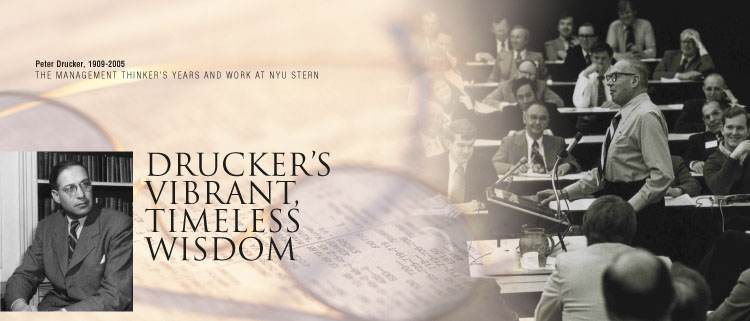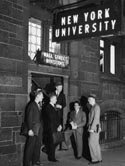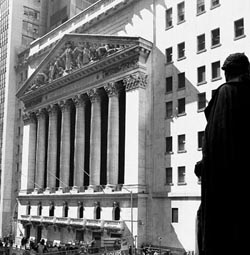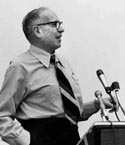
Three former chairmen of NYU Stern's Management Department assess
Drucker's life and work, and his two fruitful decades at the School.
By Dale E. Zand, Richard Freedman, and David Rogers
Peter Drucker, perhaps the most influential management thinker of the 20th century, died on November 11, 2005, at the age of 95. Drucker, who taught at NYU Stern from 1950 to 1971, was a prolific author with a remarkable ability to communicate with executives in business, nonprofit organizations, and government. The business press referred to him as “the guru of management.” And while it was not a title he sought, it was apt. Through his 40 books and hundreds of articles, Drucker changed the way academics, managers, and laypeople thought about the corporation and its role in society. For his many contributions, he was awarded the Presidential Medal of Freedom in 2002.
STERNbusiness asked several members of the NYU Stern community who knew Drucker and his work to participate in a virtual symposium on the impact he had on management – and on Stern.
 eter Drucker was born in Vienna in 1909 and was trained in political philosophy, law, and economics in Europe. He was a clerk in a Hamburg export firm, a security analyst in a Frankfurt bank, and an economist at a London bank. His writing skills brought him to America in 1937 as a correspondent for several British newspapers.
eter Drucker was born in Vienna in 1909 and was trained in political philosophy, law, and economics in Europe. He was a clerk in a Hamburg export firm, a security analyst in a Frankfurt bank, and an economist at a London bank. His writing skills brought him to America in 1937 as a correspondent for several British newspapers.
After the publication of his thought-provoking book The End of Economic Man (1939), which was favorably reviewed by Winston Churchill, Drucker became a professor of philosophy and politics at Bennington College in Vermont. In The Future of Industrial Man (1942), Drucker argued that the catastrophic effects of centralized state control in Germany and Russia leading up to World War II demonstrated that democratic socialism was a deeply flawed, unreliable political philosophy. He concluded that independent, effectively managed, industrial corporations held the key to human welfare in a democratic society.
| A Lasting Impression When he was a PhD student at Stern, Henry Kaufman (PhD '58), now chairman emeritus of the Board of Overseers at NYU Stern, was one of Drucker's pupils. In a letter to Dean Thomas Cooley last fall, Kaufman, president of Henry Kaufman & Co., remembered his former teacher: I was fortunate to be a student of his in the 1950's. His insights and perceptions left a lasting impression on me as they did on so many others. In my time, his book, The Practice of Management, had already reached wide acclaim and quite a few of the views that were expressed subsequently in his book, The Age of Discontinuity, were sprinkled in many of his lectures. What perhaps stood out to me as most significant was his capacity to spot important changes and structural developments that were bound to have an influence on management and on economic behavior. That approach left its imprint on me. During my professional career, I have tried very hard to discern the differences between current developments in business and finance and those of the past. Peter was also helpful to me in a personal way. He was one of the six professors who questioned me for three hours, a requirement for getting a PhD degree from the School. I started off very poorly in my oral defense, but at midpoint I was allowed to go to the bathroom. Peter followed me and said, “Henry, your performance during the first half hour was terrible, but you are beginning to recover, and if you now steady out, you will pass the oral examination.” I always felt that was a kindly thing for him to do considering I was just a fledgling junior banker at the time. Peter Drucker was not one of the academic breed that often dominate life at a university. Nevertheless, he was a giant in his field. Peter Drucker, Marcus Nadler, and several other professors at that time provided strong footings upon which the School was able to build an institution of even greater prominence. – Henry Kaufman |
 n 1945, General Motors invited Drucker to study its inner workings, which gave him an unusual opportunity to study management in action in a major corporation and led to his landmark book Concept of the Corporation. After writing this book, he was no longer the arms-length political economist talking about the firm as an abstract entity. He had been inside the belly of the beast. And from that point on, Drucker came to understand and appreciate the incredible impact management could have on society’s quality of life and economic well-being.
n 1945, General Motors invited Drucker to study its inner workings, which gave him an unusual opportunity to study management in action in a major corporation and led to his landmark book Concept of the Corporation. After writing this book, he was no longer the arms-length political economist talking about the firm as an abstract entity. He had been inside the belly of the beast. And from that point on, Drucker came to understand and appreciate the incredible impact management could have on society’s quality of life and economic well-being.
Fruitful Tenure
Drucker became deeply interested in management as a study in itself. He was attracted to New York University Graduate School of Business Administration (GBA), as Stern was then known, in 1950 with its student body of working managers and executives who had sufficient experience and motivation to appreciate both management theory and practice. During his tenure at the School, Drucker wrote more than 10 books. Among them were several that established his reputation as a leading thinker in management. His insights in these books are still current, almost half a century later.
Looking back, it is evident that his years at Stern were some of his greatest and most productive. The Practice of Management (1954) examined the definition of management, its role in organizations and society, and why management matters. The Effective Executive (1966) explored what makes executives productive and how they should manage the many demands on their limited capabilities and time. The Age of Discontinuity (1968) was remarkably prescient. It foresaw the rise of global organizations, the development of an interdependent world economy, the need to make the poor productive in all nations, and the dispersion of knowledge and its implications for education, work, and leadership.
Management: Tasks, Responsibilites, and Practices (1973) was Drucker’s magnum opus, a volume of almost 900 pages with 61 chapters. It was a stunning display of the scope and depth of his analytic talent and writing craftsmanship. The volume examined a huge range of topics, including the elements of business performance, managerial work and skills, workers and worker productivity, top-management tasks, corporate strategies, organization structures, and business social responsibilities.
Unconventional Wisdom
 Although many of his ideas may seem conventional today, he broke new ground when he formulated them. The Economist noted that Drucker is “the one management thinker every educated person should read.” As a teacher, his probing analysis of management issues provided students with new insights and ways of studying problems. In an age when management and marketing were taught through formalistic prescriptions built around Weber’s classic model of bureaucracies, Drucker broke the mold by focusing on the reality of problems managers faced in organizations. Ralph Davis’ The Fundamental of Top Management (1951), then one of the most widely-used management textbooks, seems ancient and irrelevant compared to Drucker’s classic, The Practice of Management (1954), which is still fresh and vibrant today.
Although many of his ideas may seem conventional today, he broke new ground when he formulated them. The Economist noted that Drucker is “the one management thinker every educated person should read.” As a teacher, his probing analysis of management issues provided students with new insights and ways of studying problems. In an age when management and marketing were taught through formalistic prescriptions built around Weber’s classic model of bureaucracies, Drucker broke the mold by focusing on the reality of problems managers faced in organizations. Ralph Davis’ The Fundamental of Top Management (1951), then one of the most widely-used management textbooks, seems ancient and irrelevant compared to Drucker’s classic, The Practice of Management (1954), which is still fresh and vibrant today.
 rucker formulated or expanded many of the basic concepts of modern management. For example, the role of profits as a cost of capital and fund for innovation; the importance of decentralization rather than huge, centralized functional departments in large organizations; the liberation of entrepreneurship; the focusing power of management by objectives; the need to understand customers and create products they want, rather than push the sale of those the firm could manufacture but customers did not want; the emerging importance of knowledge workers; the role of labor as a creative human resource rather than a disposable cost of production; the centrality of executive integrity; and the need to reign in chief executive pay. Any one of these themes could occupy the entire career of an academic or consultant. Yet they and many others rolled off Drucker’s pen year after year with new and more challenging insights.
rucker formulated or expanded many of the basic concepts of modern management. For example, the role of profits as a cost of capital and fund for innovation; the importance of decentralization rather than huge, centralized functional departments in large organizations; the liberation of entrepreneurship; the focusing power of management by objectives; the need to understand customers and create products they want, rather than push the sale of those the firm could manufacture but customers did not want; the emerging importance of knowledge workers; the role of labor as a creative human resource rather than a disposable cost of production; the centrality of executive integrity; and the need to reign in chief executive pay. Any one of these themes could occupy the entire career of an academic or consultant. Yet they and many others rolled off Drucker’s pen year after year with new and more challenging insights.
A Colleague Remembers Robert (Bob) Kavesh (BS '49), who joined NYU Stern's faculty in 1958, was Drucker's colleague for nearly a decade and a half. Peter was the great one for ideas, notions, and concepts. I have seen just about everything that he had written, and there is not a hint of an equation. During the 20-plus years that he was at NYU, the field of business education was changing, becoming more analytical and mathematical. And so there was a major difference between the Peter Drucker approach to thinking, and the later thinking. Some people may have said that he seemed to be talking common sense. But it was much more than that. When you go back, and you read some of his earlier works – like the GM study – you can see how profound and meaningful it is. When I read the works of Peter Drucker, I find myself nodding in agreement. We both lived in Montclair, NJ, and we would get together from time to time for dinners, almost always at his house. At these dinners, he'd open up a discussion, and then it was Peter Drucker almost free-associating. His mind was unbelievable. He would jump all over the place, from Japanese art to German novels, to philosophy. He was a learned man, and when given the opportunity to sit or stand at a pulpit, he was superb. He did have an accent, and that lent a little more authority to what he said. In all the years he was here, I never heard him say an unkind word about anyone. – Bob Kavesh |
He believed that nonprofit organizations, in addition to business and government, make crucial contributions to society. In his later years, he spent much time advising them, and he summarized his views in Managing the Non-Profit Organization: Practices and Principles (1990).



Top: Students gathered in front of the original NYU GBA building, located at 90 Trinity Place near Wall Street, where Drucker taught many of his classes. Center: GBA was located three blocks from the New York Stock Exchange (pictured). Bottom: Drucker taught at Stern from 1950 to 1971, and he returned annually until 1991 to conduct seminars for executives. | |
After his 22-year stint at the School, Drucker accepted a position at Claremont College in California. But he returned annually to Stern until 1991 to conduct public seminars with panels of leading academics and practitioners. For two decades, Drucker headlined the Distinguished Seminar lecture series held every April. Along with invited guest speakers, Drucker held audiences of several hundred executives captive for two days.
 rucker described himself as a journalist, writer, and teacher rather than a traditional academic scholar-researcher. Because he was accustomed to the deadlines and pressures of a journalist, he said that first he wrote as much as he could about a topic of interest and, therefore, discovered what he didn’t know. He then set about filling the gaps. This approach worked for him because he was a voracious reader, a sensitive listener, and an insightful analyst. He could reach back in history and readily illustrate his points by citing examples in economics, economic theory, government, politics, and business in Europe, the United States, and Japan.
rucker described himself as a journalist, writer, and teacher rather than a traditional academic scholar-researcher. Because he was accustomed to the deadlines and pressures of a journalist, he said that first he wrote as much as he could about a topic of interest and, therefore, discovered what he didn’t know. He then set about filling the gaps. This approach worked for him because he was a voracious reader, a sensitive listener, and an insightful analyst. He could reach back in history and readily illustrate his points by citing examples in economics, economic theory, government, politics, and business in Europe, the United States, and Japan.
Based on his experience, particularly as a writer who had to be creative while working alone, and his observations as a management consultant, he advised executives that “one can meet or one can work.” Of course he understood that some meetings were productive, but he called attention, in his pithy style, to the fact that many meetings were superfluous and accomplished little.
Traditional academics faulted him for not following the scientific paradigm of verified hypothesis – that is, proposing a testable hypothesis, gathering and quantifying data, and analyzing the data to confirm or refute the hypothesis. Drucker recognized the value of academic research and his debt to it, but never pretended to be an academic researcher.
He knew that his strength was in observation, analysis, and writing. He astutely pointed out that what is measurable is not necessarily significant, and what is not measurable is not necessarily insignificant.
Extending this point, he warned executives that the advent of computers could overwhelm them with mountains of data. Time-consuming reviews of masses of backward-looking data would not necessarily reduce uncertainty, but they could distract executives from their task of developing the perspective and generating the insight that should lead the firm into the future.
Drucker’s distinctive contribution was in bridging the gap between academic theory and the practice of management. He was a master at providing the language, the concepts, and the metaphors that elevated the practice of management. He was unique in making management understandable and sensible to executives and millions of readers.


![]()